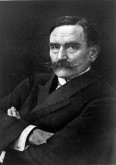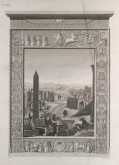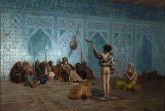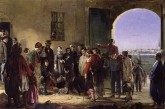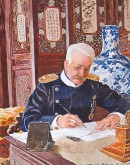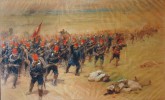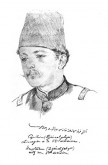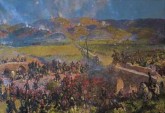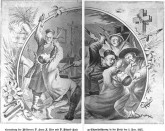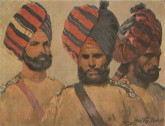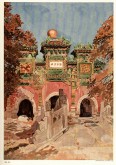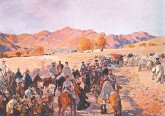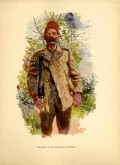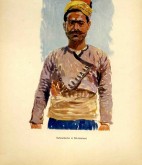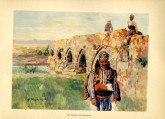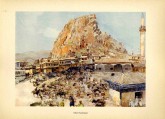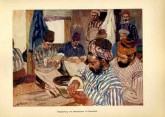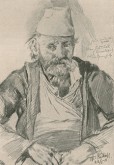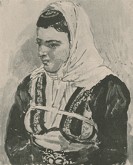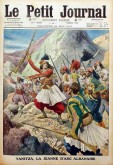The browser will either open the file, download it, or display a dialog.
A War Artist Opposite the World
The term “cosmopolitanism” has come into vogue in recent years; however, much of its usage has been uncritical. Those who speak of cosmopolitanism have stressed the mechanics of pluralist societies, both historical and contemporary. The popularity of cosmopolitanism across fields is due in no small part to the concept’s promotion by Kwame Anthony Appiah in his 2006 masterwork, Cosmopolitanism: Ethics in a World of Strangers.[1] Appiah sees cosmopolitanism as an ethical position advocating a kinship of humanity and a refutation of patriotism and nationalism, and the word has done much to counter the generic quality associated with terms like “globalization” and “multiculturalism.” However, Appiah’s concept has had a far more convincing currency in humanistic fields other than history—philosophy, law, politics—that emphasize the present and lived condition. The description of historical communities or historical figures as cosmopolitan inevitably carries an air of speculation, projective wishes, or utopian renarration. Would it be more apt, then, to talk of processes or events, rather than people, as cosmopolitan? Can one person personify a cosmopolitan process without being a cosmopolite?
This article probes these two questions through the lens of a minor artist: Theodor Rocholl (1854–1933; fig. 1), with his prolific work in a handful of international contexts. While Rocholl’s body of work falls short of being artistically very significant, it does mark a fruitful reckoning among Romanticism, Realism, and Orientalism that has a bearing on the question of cosmopolitanism and its construction through visual culture.[2]
Rocholl’s uneasy art-historical legacy is colored by a recurrent theme of failure and trauma. After training first at the Akademie der Bildenden Künste in Munich under the history painter Karl von Piloty (1826–86) and later at the Kunstakademie Düsseldorf under Wilhelm Camphausen (1818–85), another history painter, Rocholl had what appeared to be a promising career as a history painter in the Düsseldorf tradition alongside the likes of painters Carl Röchling (1855–1920) and Richard Knötel (1857–1914). Rocholl’s choleric and adventurous personality was attracted to the “aura of martialism” that was cultivated by a newly unified Germany and its emergence as a significant continental force.[3] A stream of early commissions would be stymied, however, by this predilection. A drunken fistfight in 1881 with a fellow student during a spat at the artists’ society Malkasten culminated in Rocholl’s being dishonorably removed from the army by a cabinet decision and advised to leave the artists’ society. The stigma of cowardice associated with his backing out of the completion of the fistfight, traumatic for a martialtist like Rocholl, haunted him for the rest of his life. “That evening,” Rocholl writes, “intervened with a hard and merciless fist in my existence and made me lonesome and misanthropic for years to come.”[4] Indeed, Rocholl’s oscillation between violent confrontation and extreme retreat characterized his whole world:
It was just always this oscillation between a subdued spirit and an exaggerated self-confidence. To some extent this had its root in many years of exclusion from society. Something in me had been broken back then and has never been able to mend itself again. Timidity towards new acquaintances always impeded me extraordinarily and obstructed the path to valuable relationships. And when I occasionally forced myself, an overwrought self-consciousness that cast me in an entirely wrong light came to the fore only too easily.[5]
Rocholl’s most reliable companion was painting, and life without painting represented a death in his soul. Yet it was also painting, vis-à-vis the genre in which he had trained, that thrust him into a constant confrontation with people—be they sitters for his paintings, patrons, or colleagues—with whom he was perennially ill at ease. Blacklisted from the sphere of salon culture, Rocholl was forced into piecemeal and fast-paced work as a pictorial reporter for a variety of newspapers from 1883 to about 1897, during which time he focused primarily on military affairs.[6] Rocholl’s fascination with the military and Germany abroad is inseparable from an intense nationalist fervor for the homeland or Heimat, amply evident on each page of his memoirs, Ein Malerleben. For Rocholl, Germany represented a certain truth of God, a place where simple life and sovereignty facilitated an unmatched beauty that he felt, as an artist, it was his task to represent:
Should it be possible that my quill was the tool for insistently pointing young Germans to God’s beautiful world and the joys of a simple life, to guide them to more selfless goals; that would be a reward for me that I cannot imagine to be any more beautiful?[7]
Rocholl’s alienation from the German art scene and his fascination with the military were nevertheless the reasons why Rocholl’s best opportunities lay beyond the Heimat. In 1897, Rocholl took up the opportunity to work as a freelance illustrator for the Leipziger Illustrirte’s coverage of the Greco-Turkish war in Thessaly.[8] Three years later, he was given the esteemed position of official war artist for the German expedition to China, sent to put down the anticolonial Boxer rebellion.[9] In 1909, he was hired by Deutsche Bank to illustrate the Anatolian parts of the so-called Baghdad Railway for its executives and investors.[10] Between 1910 and 1911, he lived and worked in the throes of the Turkish-Albanian war.[11] By the time of the First World War, Rocholl was over sixty, and he committed himself fully to documenting the events and atrocities of the Western front. Rocholl had, by all accounts, successfully rebounded from his career setback in Germany and confidently assumed a role at the artistic center of the German empire’s rapidly accelerating role in international affairs, particularly in the Orient, a domain long associated with the British and French.[12] Rocholl is also emblematic of the tension that Germany’s rapid geopolitical (as opposed to scholarly) entrance into the Orient created in those who harbored intense nationalistic sentiments but who needed to represent German interests in places whose geopolitical significance for the empire was fundamentally ambiguous (i.e., semicolonial). I identify this tension as “reluctant cosmopolitanism.”
The reluctance of the reluctant cosmopolitanism I use to characterize the German entrée onto the world stage in the late nineteenth and early twentieth centuries is a crucial conjugation of Appiah’s concept. As the case of Rocholl demonstrates, the Germans did not have a patent, articulated ethical concept of kinship and humanistic partnership with the “oriental” populations they began to engage on the ground after unification of the German empire in 1871. In fact, the fledgling German colonies in Africa and the Pacific were not significantly different from the administrative models of the French, British, Dutch, or other colonial powers.[13] And yet, because the internationalization of German politics came so much later than that of most of its European counterparts, and most of the colonizable world had already been divvied up, the German empire developed what could be described as a semicolonial framework to gain influence in parts of the world that were ostensibly still sovereign, China and the Ottoman Empire foremost among them.[14] Because the maintenance of dual sovereignty was necessary to sustain influence, the framework required, at least on the surface, a certain ethic of parity and equanimity and a slow tamping of Orientalist logic. Yet behind the face of this ethic was an unsullied nationalism, which distinguishes the particularity of the German situation internationally and lends it its inherently productive ambiguity that manifests itself in the form of reluctance: a simultaneous predilection to sustain Germany’s nationalism abroad and to also see the Orientals as deserving of their sovereignty.
A key element of Appiah’s cosmopolitanism is the refutation of positivism. While the Enlightenment did a great deal to unseat positivist thinking, that thinking did not evaporate as quickly as some would have it, and it suffused new, modern ideologies, such as colonialism—Napoleon’s Description de l’Égypte, with its visual language, is a case in point (fig. 2). In his critique of positivism, Appiah assesses the roles of value and belief in its construction or refutation:
Every true belief corresponds to a fact “out there” in the world, the Positivist claims. But then we’d have to abandon belief not only in values but also in possibilities, numbers, universal truths, and, one suspects, a whole lot more. A theory that sounded plausible to begin with now looks as if it comes with a pretty high price tag. It’s not that the Positivists don’t have theories about numbers and universals and possibilities. It’s that once you grasp that you have to tell a lot of different stories about different kinds of truths, the idea that observable facts are what truth corresponds to looks a good deal less obvious.[15]
The “positivist picture” Appiah describes is one in which the most tacit and common of human values cannot hold validity without factual justification. Belief, the psychological reflection of how the world is, also cannot hold water unless it can be quantified.[16] The “positivist picture” is thus an exclusive one where values and beliefs themselves hold no currency. To be sure, this is a philosophical picture, but it is also aesthetic.
As the Description de l’Égypte demonstrates, positivism had visual exponents, and the Orient was its optimal subject, as its foreignness ostensibly allowed its authors to disassociate both their values and their beliefs from the production of art.[17] The Orient was a domain of specimens—measurable, indexable, representable, and as Romanticism gave way to Realism, the Orient, now in a much closer psychological orbit with Europe, was the consummate artistic subject by virtue of its ability to be (and tradition of being) measured, indexed, and represented. But in this context it could also transcend description to become art. We know this through the oft-cited work of Jean-Léon Gérôme (1824–1904), whose The Snake Charmer (fig. 3) was famously deconstructed by Linda Nochlin:
Time stands still in Gérôme’s painting, as it does in all imagery qualified as “picturesque,” including nineteenth-century representations of peasants in France itself. Gérôme suggests that this Oriental world is a world without change, a world of timeless, atemporal customs and rituals, untouched by the historical processes that were “afflicting” or “improving” but, at any rate, drastically altering Western societies at the time.[18]
The trope of timelessness in Orientalist imagery is universal and is the manifestation of what Appiah describes as the second of two psychological states (the other is belief) that according to positivism drive all human activity: desire. Beliefs can be true or false, while desires can be satisfied or unsatisfied.[19] The Orientalist desires the Orient to be timeless, and this desire is satisfied by Gérôme’s image. But does Gérôme believe the Orient to be timeless? More importantly, does he know it to be timeless? While we cannot answer either question with any certainty, it would be fair to assume that Gérôme—and his Orientalist contemporaries—knew the Orient to decisively partake in time, to exist in a time synchronic with his. To acquiesce to this, and to represent it, would be to succumb to his beliefs rather than his desires and to jettison a “positivist” picture for a new, cosmopolitan one in which time and the recognition of its cycles of life, death, and change, are inherently necessary.
Searching for historical and aesthetic traces of such a picture in the work of Theodor Rocholl entails revising some myths about Orientalism. First, the example of Rocholl illustrates that the Orient figured outside the cycles of time only in inverse proportion to the interlocutors’ engagement with it and that a process of deorientalization began toward the end of the nineteenth century. Second, Rocholl emerges as a point of convergence between the Romantic and Realist traditions and the vicissitudes of geopolitics. The specificity of the German aspects of those three things in general, and the example of Rocholl in particular, lend grist to the conceptual mill.
War Art and the Deorientalization of the Image
The genre of war art mobilized the dynamic interplay of life and death inherent to Romantic themes, and yet it was also anathema to Romanticism’s vision of beauty. Unlike the genre’s examples from the Napoleonic and American Civil Wars, the images that emerged from wars outside the West—the Crimean War, the Greco-Turkish War, and the Boer Wars—were marked by their ambiguous relationship to Orientalist themes and tropes. The case of Rocholl certainly does not exist in a vacuum, and Jerry Barrett’s (1824–1906) The Mission of Mercy: Florence Nightingale Receiving the Wounded at Scutari (fig. 4) is a useful interlocutor with the bigger picture of emergent cosmopolitan aesthetics and the genre of war art.[20]
The central figure, Florence Nightingale (1820–1910), occupies the gravitational locus of the canvas in the entryway of the barrack hospital of the Constantinople suburb of Scutari. Through the gateway, more sick and wounded soldiers of the Crimean War can be seen ascending from the Bosphorus, and in the distance the gardens of Seraglio Point and the Hagia Sophia puncture the horizon. Rather than standing in juxtaposition to her surroundings, Nightingale is the absorptive center of this circle of experience, figured not as a “spark of life” (despite her being in Barrett’s oil spotlight) but as the giver of life—so much so, in fact, that her hand that stretches out toward the recumbent soldier appears to grace him with her power without even touching him, as if in benediction. Her presence anchors the canvas and communicates the vitality, rather than the futility, of human agency in a time of rupture and death. Nightingale is immediately flanked by her European colleagues, while Ottoman onlookers occupy the margins. Unlike the Europeans, whom we face frontally, the Ottoman onlookers, comprising a man and two children to the left and two veiled women to the right, are shadowy and mysterious, functioning primarily as signifiers of the location rather than as actors in the story. This would, of course, affirm the indexical function the Oriental figure serves on the Orientalist canvas, as well as eradicate any possible reading of the picture plane as a flat surface.[21] Yet time, famously absent in the Orientalist image, is firmly present, embodied in the cultish biographical presence and vitality of Nightingale herself and the events of the Crimean War.[22]
The Mission of Mercy exposes the contentious and unresolved ambitions between Romanticism, Realism, and Orientalism that were knotted together in the middle of the nineteenth century. It also signals the tremendous tension between the ideals of rationalist, naturalist, and exoticist representation in a time of exponentially more direct and unmediated contact between the so-called East and West. This tension was largely diffused by Impressionism, which relieved the burden to reconcile material fact with cognitive invention. But for artists outside of the avant-garde, this tension persisted well into the twentieth century and prevailed heavily among war artists like Barrett who were tasked with reconciling cycles of time with the timelessness of the increasingly familiar Orient, including artists as diverse as Wilhelm Schreuer (1866–1933), Amandus Faure (1874–1931), William Simpson (1823–99), and Godfrey Douglas Giles (1857–1941), among others.[23] By virtue of the commercial nature of their careers and their inextricable connection to the state, these artists represent a protracted and fascinating interplay between insular and increasingly retrograde ideas of style and the reluctant cosmopolitanism born of their worldly exposure.
Rocholl’s artistic transformation from academic painter to war artist in the so-called Kriegsschauplatz (theater of war), from the Greco-Turkish War through World War I, manifests as the visual result of his own reluctant cosmopolitanism and his relocation from the salon to remote corners of both the Near and Far East. Through his artistic work and his writing, we encounter Rocholl’s gradual transformation from an idealistic, nationalist painter interested primarily in allegorical historical themes to an artist-for-hire traveling Europe’s southeastern fringe, the Near East, and ultimately China, rapidly turning out prosaic, deorientalizing images. This transformation from the allegorical to the equivocal, though perhaps born of an unsought global itinerancy, also stirred Rocholl’s fervent and martial nationalism into a visual repertoire that was tentatively empathetic to both the Oriental individual and the landscapes and cultures of the Near and Far East, a transformation that vastly outpaced any of his more intellectual and progressive contemporaries back in Europe.
Much of this can be traced in detail in Rocholl’s panegyrical Malerleben, published immediately after World War I. Although largely jejune and self-congratulatory, Rocholl’s memoirs and the myriad images that complement them illustrate the softening effect Kaiser Wilhelm’s abandonment of Bismarckian isolationism in global affairs had on vernacular artistic practices.[24] This is not to say that Rocholl’s tenor is one of multicultural enlightenment; for example, he Germanizes all foreign words in his memoirs and he repeatedly indicates the superiority of German culture and the German nation. Yet one can also find traces of genuine appreciation for and absorption of other cultures—made clear, for example, in his laudatory commentary on Chinese and Japanese art.[25] Despite the fact that Rocholl often tried to isolate his German subjects from Oriental ones and their environments, his appreciation for Chinese art becomes quite obvious in a portrait of Alfred Ludwig Heinrich Karl Graf von Waldersee (1832–1904; fig. 5) who served as Allied Supreme Commander in China from 1900 to 1901.[26] Waldersee is depicted in his office at the palace in Tsingtao, Germany’s small and sole colony in the Far East, signing what are presumably important documents, with a foldable clock on the corner of the desk serving to verify the importance of time in his affairs. A large porcelain vase in traditional blue and white contrasts with Waldersee’s navy uniform. A wall of screens can be seen in the distance, each with either a plaque or a floral painting. The plaques, while too far away to be entirely legible, demonstrate that Rocholl took some care in detailing Chinese characters despite his inability to read them.
This occasional interplay of national and extranational subjects is just one indicator of how little Rocholl had in common with his contemporaries and proponents of German Impressionism and post-Impressionism. His works, rendered quickly and scripturally, do not follow stylistic models. What the images do instead is attain a degree of painterly freedom in the formal, patchwork-like structure of the image space—heralding, as it may, Expressionism and indicating the underestimated transitional power of both war art and Orientalism.
Likening art to ethnography and reportage, Rocholl saw his work as a war artist as a duty of worldly, perhaps cosmopolitan necessity—not a duty of documentation for the sake of scientific and political knowledge, but to that knowledge’s practice and aftermath. In many ways, this is a logical extension of the historical facts, with the age of imperial discovery and conquest waning and its geopolitical consequences accelerating. The last decades of the long nineteenth century, with their political unrest, particularly in Europe, were a bellwether period for Rocholl. In his own words:
The world around us does not echo of peace shawms [a Renaissance musical instrument] but rather of clashing weapons. So nothing else is as important as strengthening everything within us that reminds us of an old manly defiance. And each must contribute his part to this. As long as people cannot live in peace and prosper again, when their neighbors are against it, then they need nerves of steel and strong arms. And an old battle painter now surely has the duty to recite his little lore of the vigorous exploits of men for as long as the heart beats for our country and people.[27]
The diametric themes central to Rocholl’s view of world relations—the necessity of manly valor on the one hand and a peaceful flourishing on the other—are a distinct break from tradition. Whereas Romantic tradition was predicated largely on the powerlessness of man in the world and the emotion that evoked, Rocholl saw man, a figure often grafted onto the state itself, as eminently powerful and capable of shaping the world. Rocholl’s hundreds of artworks across decades reinforce this binary. Portraits of soldiers and battle scenes recount with swift direct strokes the cause of valor. Portraits of everyday people and village scenes recount the opposite: peaceable peoples and picturesque vistas. Yet all are firmly embedded in and expressive of time.
This is particularly true across Rocholl’s work in the Orient, which included the Greco-Turkish War of 1897, the Boxer Rebellion in 1900, images commemorating the construction of the Anatolian Railways in 1909, and works from the Balkan Wars of 1912–13. Rocholl’s memoirs generally do not focus in any great detail on the individual scale of the foreign cultures with which he came into contact. They tend to document the often banal details of his travels: where he went and when, what other Europeans he met along the way, and the most significant political events surrounding his travels, particularly in his writings on China. This is, to be sure, frustrating on one level, but it also affords the beholders of his artworks with great interpretive agency. What follows is a consideration of several key works, generated in each of these foreign contexts. The images paint a fuller picture of the dialectical nature of Rocholl’s reluctant cosmopolitanism and, to the extent that Rocholl’s work had an audience that could be affected by these images, the specific relationship those images had to the deorientalization of art.
The Greco-Turkish War of 1897
By the late nineteenth century, there was a well-established tradition of Ottoman sultans bringing European painters to the imperial capital to document the events of the court and even to train the sultans themselves in techniques of painting.[28] Under Sultan Abdülaziz, the painter was the Polish artist Stanisław Chlebowski (1835–84), with whom the sultan collaborated on a cycle of historical battle paintings as well as progressive topics that stressed the sultan’s modernizing agenda between 1865 and 1872.[29] Another prominent court painter was the Italian Fausto Zonaro (1854–1929), under the tutelage of Sultan Abdülhamid II (r. 1876–1909) from 1896 until the sultan was deposed in 1909.[30] Both Chlebowski’s and Zonaro’s focus on heroic battle painting flew in the face of the reality of contemporary Ottoman politics, which involved regular military and territorial losses. These conditions were essentially the opposite of Germany’s, which found itself in a period of great ascendancy onto the world stage.
The fact that the Ottoman Empire’s military glory was withering ever more quickly would not have been lost on either artist, particularly Zonaro, whose tenure at the court witnessed some of the empire’s most crushing upheavals. Nevertheless, Zonaro maintained a staunchly heroic tenor in his image of the Ottoman battlefield. One of his earliest paintings for Abdülhamid was a painting of the Battle of Domokos (fig. 6), a turning point of the Greco-Turkish War of 1897 and one of the few decisive victories for the German-trained Ottoman army in the latter half of the nineteenth century. Although it is clear that the request for this histrionic image depicting the Ottoman defeat of the Greek army at Domokos was the sultan’s in the first place, Zonaro does nothing to mitigate the false portrayal of the battle as an unalloyed Ottoman victory. In fact, hundreds of Ottoman soldiers perished, and yet what we see on Zonaro’s canvas is a deep, unbroken wall of Ottoman soldiers fearlessly surging up a hill. Behind them, in the distance, additional regiments make clear the plentitude of might, and in front of them the bodies of three perished Greek soldiers lie on the ground, about to be trampled.
A handful of little-known siblings to this image come to us from Rocholl, who, in 1898, painted four oil paintings related to the battle of Domokos. Rocholl had gained some notoriety in the Ottoman Empire through his visual dispatches for German periodicals from the previous year, and his output from this assignment shows the extent to which he mingled intimately with Ottoman soldiers in their time away from the battlefield. His portrait of Hasan Tahsin Paşa (1845–1918), First General of the Sixth Brigade Division, dated May 18, 1897 (fig. 7) shows an alert leader poised with binoculars in his right hand. Another portrait of a member of the same division, Captain Cemal Yahya, shows a younger soldier whose facial expression communicates an air of both sincerity and seriousness (fig. 8). These are two of a number of examples of Rocholl’s intimate depictions of Ottoman military men that rejected the commonly held European stereotype of Ottoman soldiers as fearless and yet somewhat incompetent and unmodern. This was perhaps something of an homage to the particular role the Germans had played for several decades in modernizing the Ottoman military as part of Tanzimat reforms at the bequest of the Porte.[31]
Records do not indicate that Abdülhamid was in any way disappointed with Zonaro’s depiction of the battle of Domokos or sought an alternate image, and yet he invited Rocholl to travel to Constantinople to come and paint the same scene for him.[32] His invitation appears to have also intentionally coincided with Kaiser Wilhelm II (r. 1888–1918) and Empress Augusta Viktoria’s (1858–1921) second visit to the Ottoman Empire. While Rocholl does note Istanbul’s “inexhaustible wealth of colors and shapes,”[33] he resisted long and lyrical descriptions of the exciting city because he found that such descriptions had already oversaturated European audiences:
The unforgettable Galata Bridge led me so many times over the Golden Horn into the thousandfold throng of people in Constantinople. And yet I know of the scores of thousands of countrymen who have previously gone on this same path and thus I will not bore the reader with more descriptions of Istanbul.[34]
The sultan relayed a request for four paintings depicting the Battle of Domokos through a dragoman named Humann, and Rocholl was set up in a private salon in the southwest corner of Dolmabahçe Palace to execute them. When the four canvases were complete, they were brought up to Yıldız Palace and presented to the sultan, along with a price stipulated by Rocholl.[35] Another dragoman, Tassim Bey, came to Rocholl soon thereafter with a troubling report: The sultan found the images to be beautiful but also found the price to be too expensive. The sultan’s intention had been to place the images in beautiful, elaborate frames and to present them at a grand reception for Kaiser Wilhelm and Augusta Viktoria, but Rocholl’s price would preclude the acquisition of both the images and the frames and, as a result, the sultan would buy only two of the four images for the sum of 33,000 marks (a price Rocholl probably would have considered for the four paintings).[36] The selections, now part of the Dolmabahçe Palace collection, included a battle scene that appears to show Ottomans successfully repelling Greek horsemen (fig. 9). Deliberating on the priority placed on the frames, Rocholl noted, with an air of both bitter self-consolation and suspicion: “If you know how susceptible the Oriental is to all that is shiny and splendid, you can put yourself in the sultan’s position. But was that really the whole story?”[37]
Indeed, while the rejection of two of the four paintings was said to be a financial issue, the issue was certainly more complicated. When planning for the reception for Kaiser Wilhelm and Empress Augusta Viktoria was complete and publicized, Rocholl learned that he was not among the invitees and from this understood that he had done something to fall from the sultan’s favor.[38] Palace records do not indicate the rationale for the sultan’s selection of only two of the four canvases, but the content of the other two likely holds the key to Rocholl’s fall from favor. One of them, entitled Gebet der Türken am Grabe der Gefallenen von Domokos (Prayer of the Turks at the graves of the perished at Domokos) shows a brigade of Turkish soldiers standing in solidarity and prayer at this the single deadliest battlefield (fig. 10). The brigade is likely the one known as the “Nizam” brigade, led by Nuri Paşa (1832–1900).[39] Although the Ottomans decisively won the battle of Domokos, it was probably not to the sultan’s liking that the canvas focused on any perceived loss of the Ottoman army. The identity of the second rejected painting is unknown.
The sultan’s abrupt dismissal reignited the feeling of shame that had characterized the artist’s early career in this, his most important commission. Rocholl abruptly left Constantinople and never heard from his contacts at the palace again. The air of exclusion and rejection that characterized Rocholl’s engagement with the sultan was part of a larger binary culture of inclusion and exclusion at the Ottoman court. Zonaro, for example, though a foreigner, was a welcome member of the sultan’s retinue who painted on the grounds of the sultan’s residence at Yıldız and was duly indoctrinated into court culture.[40] Rocholl’s short engagement appears to have been an audition for a similar indoctrination, one that ultimately failed. While Rocholl’s methods differed little from those of Zonaro, they bear witness to the critical nature of every visual cue on the canvas and what it could signify. In placing the Ottoman soldier, and hence the Ottoman state, within a life-death continuum, and hence in time, Rocholl unknowingly tapped into one of Abdülhamid’s deepest insecurities. Painting, like rhetoric, had to affirm the vitality and longevity of the state.
The Boxer Uprising
Whereas the so-called Kaiserzeit marked a time of intensified, actualized engagement with the Near East, the Far East remained predominantly a space of academic study, little changed from the model the sinologist Karl Friedrich Neumann (1793–1870) established in the early nineteenth century. A notable exception was the coastal German colony of Qingdao, a 213-square-mile outpost that the German empire seized from the Chinese in 1897 after a Chinese attempt (known as the “Juye Incident”) to establish the city as a fortified naval hub, an attempt which included the murder of two German missionaries.[41] German periodicals were swift to depict the gory stabbings of German and Chinese Christians, perversely comingling images of bloody daggers alongside images of Jesus on the cross (fig. 11).
German relations with China intensified and became patently confrontational as a result of the Boxer Uprising of 1899–1901, an anti-imperialist stand led by the Chinese Militia United in Righteousness (Yihetuan) and quashed by an eight-nation alliance comprising the United Kingdom, Russia, Japan, France, the United States, Italy, Austria-Hungary, and Germany.[42] Germany’s military delegation was relatively small (600 marines, 300 soldiers), and yet the intervention loomed large in the popular imagination back home in Germany. Nothing epitomizes the uncanny simultaneity of the German military and cultural roles in the Boxer Uprising more clearly than the 1902 publication Deutschland in China, overseen by Friedrich Otto Löffler, Head Commander for East Asia in the German army, with lavish and numerous illustrations by Rocholl.[43]
In order to get to China, Rocholl joined a German naval expedition led by the noted General Georg Freiherr von Gayl (1850–1927), a long sea journey that made stops in several British colonies, including Sri Lanka, India, and Singapore, picking up allied fighters along the way.[44] Rocholl appears to have been particularly struck by the regiments of Bengal, of whom he painted numerous portraits. One of these portrays three lancers (fig. 12). The composition appears to depict two different men, the leftmost man being somewhat younger and the two figures on the right depicting a somewhat older man frontally and at an angle, with the large red and black turbans and beige robes unifying his identity.
The majority of the images in the tome, however, focus on China and demonstrate both the topical and emotional range of Rocholl’s role as witness to the Uprising. The most striking distinction is that between the volume’s color plates and those in black and white. Whereas the color plates depict picturesque scenes lovingly reproduced on waxed inserts, primarily of architecture and important political happenings, the black and white images depict a grittier China of crooked streets and common people. The division of these plates was most certainly not Rocholl’s personal choice, but rather that of his collaborator and the publisher (Verlag August Bagel of Düsseldorf). Regardless, the effect is one of stark contrast: a splendid and vivid China with architectural treasures and storybook landscapes and a China of disorder, drug addiction, and gore.
This binaristic arrangement of Rocholl’s plates displaces a conventional Orientalist format. Whereas the color plates capture the timeless, immortal China, the sketchier, black and white plates, many of which are drawn over forms and telegram sheets or on scrap paper, capture a lawless, contemporary China in need of intervention. Rocholl’s depiction of an entry portal to the Forbidden City is a good example of the former (fig. 13). The painting is of a gate that appears closely related to the larger Gate to the Temple of Wisdom at the nearby Summer Palace and functions as a microcosm of much of the famed palace’s aesthetic program: three-part entryways, pink sandstone, lignum vitae pillars, inscriptions, tiered rooflines, and elaborate corbelling. The midwinter dating of the image (February 22) belies the foliage we see in the two trees framing the image on either side. The gate is entirely devoid of people. The mood is placid and in sharp contrast to the massive destruction that several fortification structures experienced over the course of the Uprising.[45]
In contrast, Rocholl gives destruction an image in a series of black and white illustrations. One recurring motif is that of decapitated heads of Boxer rebels (typically beheaded by Qing dynasty loyalists): lying in the street, affixed to poles, piled one on top of another (fig. 14). Like most battle painters, Rocholl tended to avoid such explicit and grizzly imagery, yet in the context of Deutschland in China the images do as much to unseat the picturesque images of China and to document the events of the uprising as they do to indicate Rocholl’s greater attraction to death over life and violence over history. The images also conjure up the black and white photography of Rocholl’s contemporary, the American photographer James Ricalton (1844–1929). Ricalton published similar images of death, torture, and punishment in vivid detail in his 1901 book China through the Stereoscope: A Journey through the Dragon Empire at the Time of the Boxer Rebellion (fig. 15).[46] Unlike Rocholl, Ricalton makes clear the public nature of these events and their often picturesque backdrops; yet somehow Ricalton’s tortured bodies are far less macabre than Rocholl’s, despite the directness of their medium—in part due to the swiftness of Rocholl’s stroke and the way it articulates both the casualness and the scale of violence.
In 1902, Rocholl was summoned again to a royal residence: this time Kaiser Wilhelm’s New Palace in Potsdam. The visit was arranged after the alliance had successfully quelled the Boxer Uprising and Rocholl had returned to Germany. Nervous about his most significant brush with power to date, Rocholl showed up forty-five minutes early before sitting side by side with Wilhelm and showing him the entirety of his portfolio of sketches and studies from China. Wilhelm summoned the empress and his youngest son, the 11-year-old Prince Joachim (1890–1920), to also review the images and consult with the emperor. Ultimately, Wilhelm was most taken with Rocholl’s oil canvas depicting Maximilian Graf Yorck von Wartenburg (1850–1900), a military-history instructor at the German Military Academy, entitled Zug des Grafen Yorck nach Kalgan (The procession of Graf York to Kalgan), which was acquired for the royal collection (fig. 16).[47] The image spoke to Wilhelm for its commemoration of Yorck, a beloved figure in the German military who was being groomed for a swift rise through the ranks but who would perish in China shortly after the moment captured in the image Rocholl painted.[48]
The kaiser’s selection, reflecting the primacy of symbolism over artistic merit, echoed the sultan’s selections (and rejections) a few years earlier and reinforced Rocholl’s notion that his historical scenes, replete with identifiable and significant subjects, were the most important artworks he could make. While this served to background his numerous quicker portraits of ordinary people, it also allowed these portraits to operate under the radar, as it were, insofar as Rocholl knew that they would never have any significant audience. In this sense, his keenness for painting and drawing portraits of ordinary people evolved into an intensely personal pursuit, one to be understood as an articulation of his personal cultural outlook that fills the void left by the paucity of thoughts in his writings.
The Anatolian Railway Albums
Although Rocholl had fallen out of favor with Sultan Abdülhamid II, his experience with Ottoman subjects won him a private commission from Deutsche Bank that would bring him back to Ottoman lands in 1908.[49] Deutsche Bank had been, since 1896, the primary investor and supervisory umbrella for the construction of two major railway networks: the Anatolian Railways (completed in 1896) and the Baghdad Railway (left incomplete by World War I). The Anatolian Railway Company, the managerial armature of the Anatolian Railways and a close administrative partner of Deutsche Bank, commissioned Rocholl to produce 28 aquarelles that would be issued as a limited-production album to commemorate the Anatolian Railways and its environs. The album, entitled Bilder von der Anatolischen Bahn: Den Freunden und Gästen des Unternnehmers gewidmet (Images from the Anatolian Railway: Dedicated to friends and guests of the organization), was produced at a time when additional funds and support were needed to buoy the construction of the connected Baghdad Railway, and thus, in addition to its artistic repertoire, it must be seen in its context as a marketing tool.[50] The album’s production also coincides with the Young Turk Uprising, which did as much to call the strong German presence in the empire into question as it did to remove the decorum of both the empire and religion in daily life. It was a critical moment, and Rocholl captures it in a singular way.
The series traces the landscapes of the Anatolian Railways as well as the railway line connecting Istanbul to Izmit, constructed two decades earlier. Collectively, the images of the commemorative album offer new insight into the specifically picturesque as well as ethnographic qualities the railway was perceived to have, even by its very own managers who commissioned the album. The album also traces the ways in which Rocholl managed his own experience of the Ottoman Empire with the expectations of his client. Despite the images’ proximity to the cradle of Turkish culture (in the vicinity of the Anatolian Railways terminus at Konya), the focus is not on the Mevlevi dervishes, as one might expect, but rather on the “exotic” Circassians, Greeks, and local crafts. The ethnographic images were conceived as portraits of people and places more than as individualized types, and they were imbued with a sense of whimsy rather than presented as comprehensive. The visual content of the album falls into roughly three categories: portraits, landscapes, and the chronicling of everyday life.
In the category of portraits, there is a selection of subjects who are either very young children or older men. One example is the image entitled Bahnwärter an der Anatolischen Eisenbahn (Railway attendant of the Anatolian Railway; fig. 17), which depicts a man in his fifties or sixties in a khaki-colored uniform and fez, looking dutifully at the artist. He carries a baton used to direct railway traffic in his right hand and a bag over his left shoulder that demonstrates the Ottoman adoption of the standards and uniforms of the German railways. In the background, a railway signal switch can be seen amidst a thicket of trees and vegetation. Although the man is somewhat disheveled and unshaven, his demeanor appears straightforward and trustworthy, conveying a sense of reliability and an assurance that the railway is in capable hands. A later plate, Bahnarbeiter in Dil-Jskelessi, also depicts a railway worker (fig. 18). Unlike the earlier railway employee, this worker, who is likely in his thirties, is not wearing a uniform, nor are there any indications of his presence within an actual railway environment. Rather, his portrait appears to have a purely ethnographic purpose in which his mustache, high-cropped jacket, and colorful yellow headgear combine to depict a simple yet alert man ready for work.
Rocholl’s approach to portraiture is noteworthy in two respects. First (and with the exception of the railway worker), it focuses on children and the elderly, leaving out adulthood—the bulk of human life and the apex of its productivity—and emphasizing the life–death continuum that embraces the cycles of time. Second, no adult women are portrayed, which suggests not only that women would not pose for the portraits but also that they were by no means to be gazed upon. In some ways, this moves beyond the nineteenth-century exoticization of “Oriental” women, who were typically pictured in the harem as objects of sexual fantasy, apropos of the album’s late Orientalist context when some of the more facile tropes of gender began to lose traction.[51]
The landscapes, divided between those that depict the railway, those that depict urban or village scenes, and those that depict the countryside, alternate between rather prototypical picturesque mise-en-scènes of the slow life that could just as well be somewhere in Bavaria or Britain, and landscapes that emphasize the novelty and heroicism of the railway penetrating a virgin and exotic land. Take, for example, Alte Brücke bei Karahissar (Old bridge at Karahisar; fig. 19), which offers the viewer a river scene punctuated by a ruinated bridge. The bridge is certainly one of two Roman bridges spanning the Kocaçay River, known in antiquity as the Penkalas River, near the antique site of Aizanoi. Three men, one directly in the foreground of the image, appear unfazed by the antique site as they either lounge on the bridge or go about their work nearby. Rocholl also offers us a lively glimpse into the life of Afyonkarahisar (Afiun-Karahissar; fig. 20). Central to the image, as in virtually all images of that city, is the dramatic outcropping that dwarfs the city’s demure skyline and provides a home for its medieval citadel. In the foreground is the city’s central marketplace and mosque, with the city’s bustling commercial life evinced through the depiction of countless figures moving to and fro as well as carts, cattle, and large sacks of goods.
The remaining images, depicting men at work, heroicize simple labor—farming, salesmanship, crafts, etc.—and memorialize a land that, despite all of the recent railway construction and industrial development, is largely agrarian and remains, in crude yet blissful simplicity, timeless. In the subsequent image, Bearbeitung von Meerschaum in Eskischehir (Production of meerschaum in Eskişehir; fig. 21), the viewer is given a glimpse behind the scenes into the production of the product. Nine men can be seen in the image: seven of them are either seated or on their knees working intensively with the material, while the other two men in the background appear to be overseeing their work. The image is evocative in many respects. Most notably, it depicts an unusual moment of handicraft as the province of men, not the women with whom these types of scenes were more commonly associated. The work environment is relaxed and convivial, unlike a factory setting, and one can imagine the men sharing stories and jokes with one another while their hands keep busy.
Rocholl’s albums, by virtue of their limited production, were not widely seen, and the intimate nature of their circulation is redoubled by the intimate nature of the portraits of people and landscapes. They are also expressive of Rocholl’s interest in the common person and place, existing well within time and outside the arsenal of common Orientalist tropes. It is, perhaps, the intimacy of their circulation that allowed Rocholl to engage the railway’s landscapes in all of their specificity and to capture a land that Rocholl knew was undergoing rapid change, both internal and external to the state.
The Albanian Revolts of 1910 and 1911
Less than a year after completing his studies for the Anatolian Railways, Rocholl was at work yet again in the Ottoman Empire. His project, like the one in China, was to document the tumult of an uprising—this time in Albania, which was shaken by a series of successive nationalist revolts in the years leading up to the outbreak of the Great War. Like his work in Greece in 1897, Rocholl’s focus was on the irredentist fringes of the empire, although in this case Rocholl’s purview is from the side of rebels rather than the state.[52] Fearing further territorial dissolution in this, one of the empire’s most docile minority provinces, the Ottoman government’s goals in Albania were centralization and the suppression of nationalism. Rocholl’s work in Albania demonstrates an even greater level of intimacy with his subjects than in Anatolia; his sketches and paintings alike are significantly more detailed and have a level of proximity to the rebels that indicates a greater ease of access to his subjects and environs. The subject of his work in Albania altogether avoids the battle-scene themes that were the centerpiece of his work in Greece. To be sure, there were battles during these years, but Rocholl’s decision to document none of them is significant in the primacy it places on the individual and the civilian experience.
With the exception of some portraits of the Ottoman military general Şevket Turgut Paşa (1857–1924), Rocholl’s portraits in Albania are nearly exclusively of the Malissori, an associated group of Muslims and Catholics living in the highlands of northern Albania. The Malissori had long enjoyed a level of autonomy within the Ottoman political system as part of a special system known as kanun, which stipulated a high level of territorial sovereignty and exemption from certain tax and military regulations.[53] Despite this relative level of freedom within the Ottoman framework, Albania proved not to be immune to the wave of nationalism that had been sweeping the Balkans for decades. Known as the Albanian National Awakening, the uprisings of 1910 and 1911 were reactions to the Young Turks’ attempt to Ottomanize the Albanians (one of the few Ottoman provinces remaining in Europe) and to bring the region into a centralized Ottoman system.[54]
The Malissori, with financial and munitions support from the Kingdom of Serbia, led the charge against the Young Turks by blockading railway lines and attempting to block Ottoman military infiltration in the region.[55] The level of access to subjects in the Albanian highlands that Rocholl was able to attain is plainly evident in a portrait entitled Alter Katschak aus dem Stamme Gruda (Old fugitive of the Gruda tribe; fig. 22). Rocholl tells us nothing about this specific man, but from his writings we know that the man is one of a handful of fugitives that he met in the highlands. The fact that this man is from the Gruda tribe, a historical group of ethnic Albanians native to southeastern Montenegro, and that he is elderly tells us a great deal about the scope of the rebellion: it was drawing old as well as young supporters in solidarity with ethnic Albanians from outside the highlands. The fugitive holds his hands tentatively in his lap, with his weathered face carrying an expression that indicates a mix of anxiety and confidence, bearing witness to both his vulnerability and his resilience.
Rocholl’s personal focus in Albania, however, was primarily on the young. His portrait of a young Malissori from 1911 (fig. 23) depicts a man, roughly twenty years in age, poised with a pistol and draped in a bandolier. His pose is proud and alert, and Rocholl’s vertical format stresses the young fighter’s agility. The dating of Rocholl’s portrait—May 17, 1911—is also crucial. Three days earlier, Turgut Paşa had ordered his troops to seize the city of Dečić. The Malissori and other Albanian tribes were set to meet in Podogorica the next day to deliberate whether they would acquiesce and turn the city over to the Ottomans. As such, the young fighter’s ready pose also indicates a loyalty to the tribal system and its governance.
Rocholl also depicted civilians, including a young Malissori woman from the Montenegrin city of Fundina (fig. 24). It is unclear what brought Rocholl to Fundina, but the significance of the city would not have been lost on an Ottoman audience, as it was the site of a major loss (almost 16,000 casualties) for the Ottoman military during the Montenegrin-Turkish War of 1876–78 and thus a stronghold of Montenegrin as well as Albanian national sentiment. The woman, looking intently down to the side, is bedecked in a shawl and holds her hands in her lap just below the image frame. It is possible that Rocholl was actually depicting Tringë Smjl Martini Ivezak (1880–1917; known as “Yanitza” outside Albania), a female guerilla Gruda fighter who participated in the uprisings and was distinguished for her heroism on the battlefield. Yanitza was canonized in Albanian and Montenegrin folklore and garnered attention in international circles, for example, on the cover of Le Petit Journal, as the Albanian Joan of Arc (fig. 25).[56]
Rocholl did not, however, document the trauma endured by many of those he drew. As in China, rebels were executed in public, and numerous entire villages and even more properties were burnt to the ground. The Albanian language was rendered illegal, as were any publications written in it.[57] The images bear witness only to the moments of nationalist optimism and articulate Rocholl’s slow rejection of formulaic and martial visual themes in favor of more personal ones.
Conclusion
Viewed purely as a synthesis, the combination of martial and folkloric themes in Rocholl’s visual output with the nationalist undercurrent expressed in his writings would seem to posit Rocholl as a progenitor of the anti–avant-garde ethos that would later characterize the Third Reich. So much so, in fact, that this synthesis could explain why so few, in Germany or elsewhere, have undertaken any sustained analysis of Rocholl’s work.[58] It would nevertheless be premature and indicative of the perils of teleology and the privileging of one portion of history over another to associate Rocholl with National Socialism and assume he had a protoideological connection to it and its aesthetic principles. Moreover, the scant critical consideration that has been given to Rocholl’s work has more or less bypassed his work abroad, a body of work that encompasses about half of his total output. Perhaps because it is more difficult to understand exactly what Rocholl has to say about the Heimat in these images, they have been construed as outliers.
One descriptor these works have not earned, however, is Orientalist, despite their obvious relationship to the Orient and their synchronicity with the heyday of academic German Orientalism. Regarding academic Orientalism, Suzanne Marchand has similarly ruminated on the nonlinear nature of history:
Had the Weimar era gone on, it is possible that German Orientalism would have evolved more fully in the direction of what we now call multiculturalism. It had many of the makings of such a worldview . . . there was already a powerful understanding of the Eurocentric nature of conventional history-writing and the unsuitability of Western models and norms for understanding the cultures of the East. There was an appreciation of the ways in which Europe was, for most of recorded history, the weaker continent, and of how many myths, ideas, inventions, and practices . . . Europeans owed to the Orient.[59]
Ultimately, however, inherent limitations prevented German Orientalist knowledge in the academy from fully bearing out the modern multicultural paradigm, and Marchand notes that the inability “was the result of [the] deep [German] immersion in the Christian and classical traditions and the attendant prejudices and institutional barriers that made thinking outside these boxes difficult and fraught with peril—as well as exhilaratingly iconoclastic.”[60]
Marchand’s thesis is convincing, and yet it is also important to note that it would only be scholars, not professionals or artists such as Rocholl, who would have this humanistic preoccupation. Rocholl’s professional role as war artist in the Orient was not an Orientalist endeavor per se, as we clearly know from his indifference to the Orient in his writings. And while he may have drawn upon some earlier forms of Orientalist visual convention, the immediacy of his work in situ and the reintegration of time and personhood in his images decelerated and even reversed the production of Orientalist imagery. Marchand contends that German Orientalism laid the foundations for cosmopolitan thinking but was unable to develop it.[61] This study suggests an expansion of this idea, revealing the impact of Orientalist knowledge on artists as well as nationalists like Rocholl, not just academics.
Let me now return to the two questions I posed at the beginning of this study. Would it be more apt to talk of processes or events, rather than people, as cosmopolitan? Can a person embody a cosmopolitan process without being a cosmopolite? As ideas of the world internal to the individual, Romanticism and Realism—the traditions from which Rocholl’s particular brand of image-making emerged—by definition demand the artist to embody their art. Cosmopolitanism, on the other hand, as either a social or an aesthetic idea, is fundamentally different in that it necessitates a twofold condition, one of which is empathy to its ideals within the individual and the other of which is a setting of worldly exposure, external to the individual, through which that empathy can be cultivated. As Appiah notes:
Because there are so many human possibilities worth exploring, we neither expect nor desire that every person or every society should converge on a single mode of life. Whatever our obligations are to others (or theirs to us) they often have the right to go their own way. . . . There will be times when these two ideals—universal concern and respect for legitimate difference—clash. There’s a sense in which cosmopolitanism is the name not of the solution but of the challenge.[62]
Indeed, Rocholl’s images abroad represent a challenge rather than a solution, and the inherent clash of universal concern and respect for legitimate difference is precisely what makes them new and destabilizing. They cannot coalesce an ideology, as we might expect, because their author is unsettled by the fissures between what he thinks, what he sees, and ultimately what he depicts. The reluctant nature of Rocholl’s particular internationalizing and Wilhelmine context demonstrates the incongruity between ideology and empathy that cosmopolitanism can manifest, a moment where the visual speaks to a process its author never could.
The author would like to thank the staff of the Stadtmuseum Hofgeismar for opening their doors and sharing materials on Theodor Rocholl.
Unless otherwise noted, all translations are those of the author.
[1] Kwame Anthony Appiah, Cosmopolitanism: Ethics in a World of Strangers (New York: W. W. Norton, 2006).
[2] There is not a great deal of literature on Rocholl. Sources include Helmut Burmeister and Veronika Jäger, eds., China 1900: Der Boxeraufstand, der Maler Theodor Rocholl und das “alte China” (Hofgeismar: Verein für hessische Geschichte und Landeskunde e.V. Zweigverein Hofgeismer, 2000); Helmut Burmeister, Begegnungen im Märchenwald: Der Maler Theodor Rocholl und der Reinhardswald (Hofgeismar: Verein für hessische Geschichte und Landeskunde e.V. Zweigverein Hofgeismer, 2004); Bernd Küster, Der Erste Weltkrieg und die Kunst von der Propaganda zum Widerstand (Oldenburg: Gifkendorf Merlin-Verlag, 2008); Oliver Gradel and Silke Köhn, Künstler im Weserbergland und die Düsseldorfer Malerschule (Bönen: Schloss Corvey, 2010), 126; Silke Köhn, “Theodor Rocholl 1855–1933,” Sammler Journal, June 2009, 66–75; and Ulrich Thieme and Felix Becker, eds., “Theodor Rocholl,” Allgemeines Lexikon der Bildenden Künstler von der Antike bis zur Gegenwart (Leipzig: E.A. Seemann, 1934), 28:450. Rocholl’s letters from World War I are collected in Theodor Rocholl, Kriegsfahrten deutscher Maler: Selbsterlebtes im Weltkrieg 1914–1915 (Bielefeld and Leipzig: Velhagen & Klassing, 1916). Rocholl’s memoirs are published as Theodor Rocholl, Ein Malerleben (Berlin: Verlag de täglichen Rundschau, 1921). On war art in general, see Arnold D. Harvey, A Muse of Fire: Literature, Art and War (London: Bloomsbury, 1998). Many works by Rocholl are held by the Stadtmuseum Hofgeismar. The museum’s director, Helmut Burmeister, graciously walked me through this material and other written records about Rocholl in July 2014.
[3] Alexander Roob, “Der gebrochen Historienmaler,” Melton Prior Institut, March 30, 2009, accessed January 18, 2016, http://meltonpriorinstitut.org/pages/textarchive.php5?view=print&ID=35&language=English.
[4] Rocholl, Malerleben, 68.
[5] “Es war eben immer das Pendeln zwischen gedrückter Stimmung und übertriebenem Selbstbewusstsein. Etwas hatte das doch immer seinen Ursprung in den vielen Jahren der Ausscheidung aus der Gesellschaft. Etwas war damals in mir geknickt worden und hat sich nie wieder aufrichten können. Eine gewisse Scheu vor neuen Bekanntschaften hat mich stets außerordentlich gehindert und mir den Weg zu wertvollen Beziehungen verbaut. Und wenn ich mich dann mal zwang, so kam nur zu leicht ein überreiztes Selbstgefühl zum Vorschein, das mich in ganz falsches Licht brachte.” Quoted in Roob, “Der gebrochen Historienmaler.”
[6] Rocholl, Malerleben, 76–105.
[7] “Sollte es möglich sein, daß meine Feder das Werkzeug war, junge Deutsche eindringlich hinzuweisen auf Gottes schöne Welt, auf die Freuden eines enfachen Lebens, sie hinzuführen zu selbstloseren Zielen, so wäre das eine Belohnung für mich, wie ich sie mir schöner nicht denken kann.” Ibid., 254.
[8] Ibid., 106–18, 127–42.
[9] Ibid., 149–66.
[10] Ibid., 176–83.
[11] Ibid., 184–217.
[12] Suzanne Marchand has suggested that German-speaking Central Europeans conjured a counterdistinctive “Orient” premised on a longing to understand the Near East as a basis for interpreting the New Testament, biblical lands, and the history of Christianity. See Suzanne Marchand, German Orientalism in the Age of Empire: Religion, Race, and Scholarship (New York: Cambridge University Press, 2009), esp. 1, 495–99.
[13] On the particularities of German colonialism, see Nina Berman and Klaus Mühlhan, German Colonialism Revisited: African, Asian, and Oceanic Experiences (Ann Arbor: University of Michigan Press, 2014); Sebastian Conrad, German Colonialism: A Short History (Cambridge: Cambridge University Press, 2012); Horst Gründer, Gisela Graichen, and Holger Diedrich, Deutsche Kolonien, Traum und Trauma (Berlin: Ullstein, 2005); Volker Langbehn, German Colonialism, Visual Culture, and Modern Memory (London: Routledge, 2012); Michelle Moyd, Violent Intermediaries: African Soldiers, Conquest, and Everyday Colonialism in German East Africa (Columbus: Ohio University Press, 2014); Winfried Speitkamp, Deutsche Kolonialgeschichte (Leipzig: Reclam, 2014); and George Steinmetz, The Devil’s Handwriting: Precoloniality and the German State in Qingdao, Samoa, and Southwest Africa (Chicago: University of Chicago Press, 2007).
[14] Other significant examples of “semicolonialism” include the historic cases of Persia, Thailand, Afghanistan, Yemen, and Ethiopia. This is an adapted definition of the term semicolonialism as it is outlined by Gordon Marshall, “semi-colonialism,” A Dictionary of Sociology (1998), Encyclopedia.com, accessed January 19, 2014, http://www.encyclopedia.com/doc/1O88-semicolonialism.html.
[15] Appiah, Cosmopolitanism, 23–24.
[16] Ibid., 18.
[17] Charles Louis Fleury Panckoucke, Description de l’Égypte ou Recueil des observations et des recherches qui ont été faites en Égypte pendant l’expédition de l’armée française (Paris: Imprimerie Imperial, 1809–1822). See also Yves Laissus, L’Égypte, une aventure savant (Paris: Fayard, 1998).
[18] Linda Nochlin, “The Imaginary Orient,” Race-ing Art History: Critical Readings in Race and Art History, ed. Kymberly N. Pinder (London: Routledge, 2002), 70. Original from Art in America, May 1983, 118–31, 187–91. Ibn Warraq fiercely criticizes Nochlin’s essay and its supposedly summary dismissal of the genre of Orientalist painting. While this author does not agree with Warraq, his critique prompts a consideration of some of the ways in which a first wave of post-Saidian analysis failed to reckon with more granular and contextual aspects of history. See Ibn Warraq, “Linda Nochlin and the Imaginary Orient,” New English Review, June 2010, accessed January 18, 2016, http://www.newenglishreview.org/Ibn_Warraq/Linda_Nochlin_and_The_Imaginary_Orient/.
[19] Appiah, Cosmopolitanism, 18.
[20] Regarding Barrett and his context, see Matthew Paul Lalumia, Realism and Politics in Victorian Art of the Crimean War (Ann Arbor: UMI Research Press, 1984). Mark Bostridge notes that Florence Nightingale did not want to participate in Barrett’s portrait. Mark Bostridge, Florence Nightingale: The Making of an Icon (London: Viking, 2008), 20.
[21] On the indexicality of photography in Orientalism, see Ali Behdad, “The Orientalist Photograph,” in Photography’s Orientalism: New Essays on Colonial Representation, ed. Ali Behdad and Luke Gartlan (Los Angeles: Getty Research Institute, 2013), 11–32.
[22] In addition to Nochlin’s discussion of timelessness in Orientalist art, see Jill Beaulieu and Mary Roberts, eds., Orientalism’s Interlocutors: Painting, Architecture, Photography (Durham, NC: Duke University Press, 2002); Joseph A. Boone, The Homoerotics of Orientalism (New York: Columbia University Press, 2014); John M. MacKenzie, Orientalism: History, Theory and the Arts (Manchester: University of Manchester Press, 1995); and Edward Said, Orientalism (New York: Vintage, 1978), esp. 118–19.
[23] Regarding Giles, see Peter Harrington, British Artists and War: The Face of Battle in Paintings and Prints, 1700–1914 (London: Greenhill, 1993). Regarding Faure, see Rocholl, Kriegsfahrten. Regarding Schreuer, see O. W. Höllig and Wilhelm Körs, Wilhelm Schreuer 1866–1933: Ein Düsseldorfer Maler der guten alten Zeit (Düsseldorf: Stern, 1997). Regarding Simpson, see Mildred Archer, Visions of India: The Sketchbooks of William Simpson (Topsfield, MA: Salem House, 1986); Peter Harrington, “Simpson’s Crimean Sketchbooks,” The War Correspondent 19, no. 1 (2001): 10–12; and William Simpson, “Symbolism of Oriental Ornament,” Royal Society of the Arts Journal 22 (1874): 488–94.
[24] See, for example, John C. G. Rohl and Nicolaus Sombart, Kaiser Wilhelm II—New Interpretations: The Corfu Papers (Cambridge: Cambridge University Press, 2005).
[25] Rocholl, Malerleben, 150–66.
[26] On Waldersee and his time in China, see Hans Mohs, ed., General-Feldmarschall Alfred Graf von Waldersee in seinem militärischen Wirken (Berlin: Eisenschmidt, 1929).
[27] “Die Welt ringsum hallt nicht wider von Friedenschalmeien wohl aber von klirrenden Waffen. Da tut nichts dringender not, als alles in uns zu stärken, was uns an die alte Mannhaftigkeit und den alten Trotz mahnt. Und dazu hat ein jeder sein Teil beizutragen. Solange es einem Volke nicht möglich ist, in Frieden zu gedeihen und neu aufzublühen, wenn es den Nachbarn nicht gefällt, solange gilt es stahlharte Nerven und zur Abwehr bereite kraftvolle Arme zu haben. Und ein alter Schlachtenmaler hat doch wohl jetzt die Pflicht, sein Sprüchlein aufzusagen von kräftigen Männertaten, solange das Herz für unser Land und Volk schlägt.” Rocholl, Malerleben, 256.
[28] Mary Roberts details these interactions in Istanbul Exchanges: Ottomans, Orientalists, and Nineteenth-Century Visual Culture (Berkeley: University of California Press, 2015), esp. 1–4.
[29] Ibid. The sketches produced by the sultan were published in several works: Annie Brassey, Sunshine and the Storm in the East, or Cruises to Cyprus and Constantinople (London: Longmans, Green, 1880), 11; Mieczysław Treter, “Rysunki Sułtana Abdul-Azisa,” Lamus 4 (1908–9): 55–63; Michał Pawlikoski, “Studio Talk: Cracow,” Studio 57 (1913): 162–63; and M. Sami, “Selatinde İncizab-ı Tersim,” Osmanlı Ressamlar Cemiyeti Gazetesi 14 (March 1, 1914), reprinted in Yaprak Zihnioğlu, ed., Osmanlı Ressamlar Cemiyeti Gazetesi, 1911–14 (Istanbul: Kitap Yayınevi, 2007), 185–86. Chlebowski’s papers are held at the Jagiellonian Library in Krakow.
[30] Roberts, Istanbul Exchanges, 137–50. Other sources on Zonaro include Giovanna Damiani, Roberta Ferraza, and Ömer Faruk Şerifoğlu, Fausto Zonaro: From the Venice Lagoon to the Shores of the Boshphorus, An Italian Painter at the Court of the Sultan (Istanbul: Yapı Kredi Kültür Sanat Yayıncılık, 2004); Aykut Gürçağlar, “Padualı Bir Ressam Gözüyle: Zonaro’nun İstanbulu’u,” Türkiyemiz Kültür ve Sanat Dergisi 65 (October 1991): 20–31; Osman Öndeş and Erol Makzume, Fausto Zonaro (Istanbul: Yapı Kredi Yayınları, 2003); and Adolphe Thalasso, “Peintre de S.M.I. le Sultan,” Figaro Illustré 203 (February 1907): 21–32.
[31] Amid the parade of defeating events, Abdülhamid appealed to Wilhelm I in 1880 for guidance in reordering the military. Colmar Freiherr von der Goltz (1843–1916), a decorated Prussian soldier, was brought to Istanbul in 1883 for the task. Over the course of twelve years, he managed to shape a generation of “fumbling” Turkish fighters into modern military men while simultaneously preventing the modernization from meaning a break of allegiance to the sultan. See Handan Nezir Akmeşe, The Birth of Modern Turkey: The Ottoman Military and the March to World War I (New York: I. B. Tauris, 2005), 22–23. Von der Goltz’s memoirs were also published: Freiherr Colmar von der Goltz, Denkwürdigkeiten (Berlin: E. S. Mittler, 1932).
[32] Rocholl, Malerleben, 139.
[33] “At the Hotel London, quite at the top of Pera, I just threw my backpack (the reader knows it already) off my shoulders to wander through the streets of the city as soon as possible and to take possession of the often dreamt, never seen images, of the inexhaustible wealth of colors and shapes with my own humble eyes.” / “[I]m Hotel London ziemlich auf der Höhe von Pera [warf] meinen Rucksack (der Leser kennt ihn bereits) von den Schultern und möglichst schnell [wanderte ich] durch die Straßen der Stadt, um mit eigenen dürftigen Augen Besitz zu ergreifen von viel geträumten, nie gesehenen Bildern, von unerschöpflichem Reichtum an Farben und Formen.” Ibid., 128.
[34] “Die unvergeßliche Galatabrücke führte mich zum alleresten Male über das Goldene Horn in das tausendfältige Menschengewimmel von Konstantinopel. Ich weiß jetzt aber gut genug, wieviele Tausende unserer Landsleute seitdem und vordem diesen selben Weg gegangen und gefahren sind, um die Leser nicht mit Schilderungen Stambuls zu langweilen.” Ibid.
[35] Ibid., 140.
[36] Ibid.
[37] “Wenn man weiß, wie empfänglich der Orientale für alles Glänzende und Prächtige ist, kann man sich in des Sultans Lage versetzen. Aber war das alles?” Ibid.
[38] Ibid.
[39] For details about this brigade, see Carl L. A. Fetzer, Aus dem thessalischen Feldzug der Türkei Frühjahr 1897: Berichte und Erinnerungen eines Kriegskorrespondenten (Stuttgart: Deutsche Verlags-Anstalt, 1898), 153–54.
[40] Roberts, Istanbul Exchanges, 141.
[41] See Schultz-Naumann, Unter Kaisers Flagge (Montreal: Universitas, 1985), 182–83.
[42] On the Boxer Uprising (often called the “Boxer Rebellion”), see Paul A. Cohen, History in Three Keys: The Boxer as Event, Experience, and Myth (New York: Columbia University Press, 1997); and Joseph W. Esherick, The Origins of the Boxer Uprising (Berkeley: University of California Press, 1987). On the German Empire’s role in the Boxer Uprising, see Annika Mombauer, “Wilhelm, Waldersee, and the Boxer Rebellion,” in The Kaiser: New Research on William II’s Role in Imperial Germany, ed. Annika Mombauer and Wilhelm Desit (Cambridge: Cambridge University of Press, 2009), 91–118.
[43] Friedrich Otto Löffler, Deutschland in China (Düsseldorf: A. Bagel, 1902).
[44] Rocholl, Malerleben, 149–51.
[45] For detailed documentation of the architectural destruction that took place as a result of the Boxer Rebellion, see Peter Harrington, Peking 1900: The Boxer Rebellion (Wellingsborough, UK: Osprey, 2001), 52–84. Rocholl devotes a great deal of attention to the descriptions of key architectural sites in Peking, Shanghai, and Kalgan; see Rocholl, Malerleben, 149–66.
[46] James Ricalton, China through the Stereoscope: A Journey through the Dragon Empire at the Time of the Boxer Rebellion (New York: Underwood & Underwood, 1901).
[47] Rocholl, Malerleben, 164.
[48] See Bernhard Schwertfeger, Die grossen Erzieher des deutschen Heeres: Aus der Geschichte der Kriegsakademie (Potsdam: Akademische Verlagsgesellschaft Athenaion, 1936), 138.
[49] It is unclear whether there is a direct connection, but Rocholl was also asked to depict the events surrounding the hundred-year celebration of the Essen-based Krupp company, Germany’s foremost steel manufacturer and the largest supplier of rail material for the Ottoman railways. A reproduction of the painting is archived online at The-Atheneum.org., accessed May 9, 2014, http://www.the-athenaeum.org/art/full.php?ID=132556. It is not clear where the painting is held, but the location is likely the Sammlung Krupp von Bohlen und Halbach in Essen.
[50] Historisches Institut der Deutschen Bank. Stored as a special holding: Anatolische Eisenbahn-Gesellschaft, Bilder von der Anatolischen Bah: Den Freunden und Gästen des Unternnehmens gewidmet, Privatdruck, ca. 1908, Deutsche Bank, Historisches Institut, Frankfurt.
[51] See Mary Roberts, Intimate Outsiders: The Harem in Ottoman and Orientalist Art and Travel Literature (Durham, NC: Duke University Press, 2007).
[52] Rocholl, Malerleben, 185–217.
[53] For an overview of the nature of the relationship between the late Ottoman government and the province of Albania, see Miranda Vickers, The Albanians: A Modern History (London: I. B. Tauris, 2006).
[54] See Stavro Skendi, The Albanian National Awakening, 1878–1912 (Princeton: Princeton University Press, 1967), 335–463. See also Zuzana Finger, “Die albanische Nationsbildung,” in Albanien: Geographie, historische Anthropologie, Geschichte, Kultur, postkommunistiche Transformation, ed. Peter Jordan and others (Bern: Peter Lang, 2003), 135–49; and Stephanie Schwandner-Sievers and Bernd J. Fischer, Albanian Identities: Myth and History (Bloomington: University of Indiana Press, 2002).
[55] Frank Moore Colby and Allen Leon Churchill, New International Yearbook: A Compendium of the World’s Progress (New York: Dodd, Mead, 1912), 712. See also John D. Treadway, The Falcon and the Eagle: Montenegro and Austria-Hungary, 1908–1914 (West Lafayette, IN: Purdue University Press, 1998), 47–79.
[56] For the story of “Yanitza,” see Stefanaq Pollo and Selami Pulaha, Akte te Reilindjes Kombëtare Shqiptare 1878–1892: Memorandume, vendime, protests, thirrje (Tirana: Academy of Science of the Albanian SPR, Institute of History, 1978), 30–33; and “Albanian Joan of Arc: Handsome Heroine Takes Father’s Place and Vanquishes Turks,” New York Times, May 21, 1911.
[57] Skendi, Albanian National Awakening, 405–37.
[58] Roob acknowledges this and notes: “He glares at us from his photographic portrait like a grim Wilhelminian member of the master race with a Nietzsche-style moustache—and the gloomy appearance is by no means deceptive. Rocholl’s worldview, expressed in his autobiographic writings, is entirely imbued with blood and soil. German army and German victory, German horse and German Great Dane—those were the preferred motifs of his paintings, and in his illustrations stiff, meaty Germanic hordes wander through scraggy oak woods. If 80-year-old Rocholl had not fallen victim to a streetcar accident in the year the Nazis seized power, he would probably have been apotheosized during the Third Reich similar to the way younger Arthur Kampf was. That one tends to stay clear of such a perfect example of an oeuvre filled with ultra-nationalistic and proto-‘Brown’ motifs is understandable, since one doesn’t want to burn one’s fingers.” Roob, “Der gebrochen Historienmaler.”
[59] Marchand, German Orientalism, 496.
[60] Ibid., 497.
[61] Ibid., 495–99.
[62] Appiah, Cosmopolitanism, xv.


